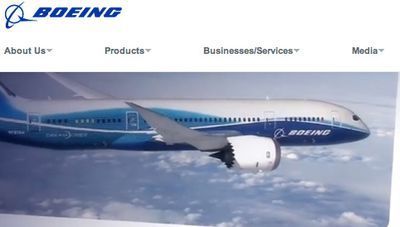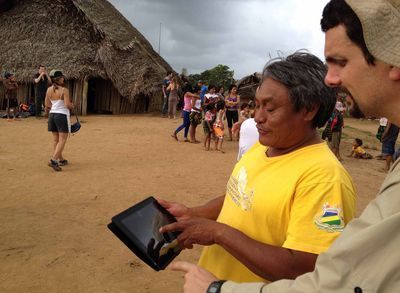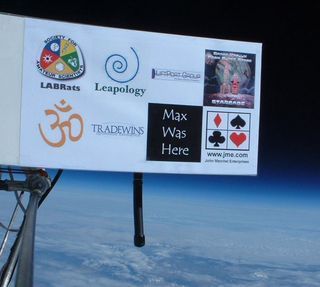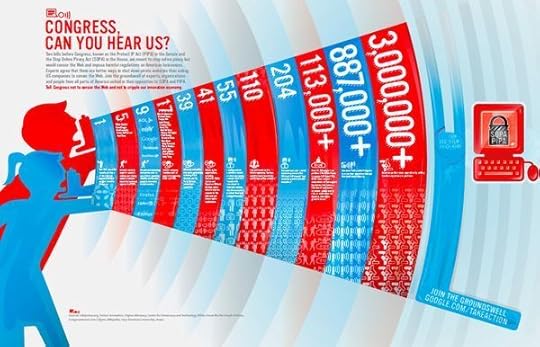David Meerman Scott's Blog, page 88
February 17, 2012
KLM social media Meet and Seat
My friend Gerard Vroomen, who lives in Amsterdam and flies KLM frequently, alerts us to KLM Meet and Seat.
Gerard (who tweets at @gerardvroomen and has an excellent blog) is a co-founder of Cervelo, the premier high end racing bike company. He built his company by focusing on a great product for his buyers (including road racers and triathletes) and by building a huge and passionate following through social media. So when Gerard brings something to our attention it is certainly worth checking out.
 The KLM Meet and Seat lets those booked on certain KLM long-haul flights find out who else will be on flight too. With Meet & Seat you can view other passengers' Facebook or LinkedIn profile details and see where they'll be sitting – long before the flight leaves the ground.
The KLM Meet and Seat lets those booked on certain KLM long-haul flights find out who else will be on flight too. With Meet & Seat you can view other passengers' Facebook or LinkedIn profile details and see where they'll be sitting – long before the flight leaves the ground.
You might search for people who are going to the same conference as you. Or someone from the same industry.
Opt-In to Meet and Seat
The KLM Meet and Seat service is opt-in. You can still be anonymous if you want. Or you can share your Facebook or LinkedIn profile through the KLM Manage my Booking interface. Once you share yours you can see the profile details of other passengers as well as their seat assignment (you can even try to sit next to someone interesting).
"I think this is a great way to use the capabilities of social networks," Gerard says. "Let's face it, many airline offerings are very similar and the consumer focuses on price a lot, so any time you can get your customer to think about something else, that's a good thing. Of course, KLM has to be careful it doesn't backfire, you can't run before you can crawl. Their website has had problems in times of crisis (Icelandic volcano, snowstorm at Schiphol airport) where online management of bookings wouldn't work, and their call centers would only play a recording telling people to manage their bookings online and then hang up on them. If you offer fancy services but the basics don't work, you'll take a real beating. But presuming they got the basics working now, this is a great addition and it also shows the benefits of being original; people will talk about it simply because you're the first to implement it."
KLM is a social media pioneer. When Foursquare first took off, they created a KLM Surprise program for those who checked into their flight on Foursquare at the airport gate. Sometimes, KLM staff would surprise you with an upgrade or travel bag or some other gift.
Each of these interesting KLM social initiatives are designed to get people to talk about the airline on their social networks. Imagine being seated next to your next customer or business partner (or even your future spouse) as a result of the social matchmaking.
Interesting stuff. Thanks Gerard.
February 14, 2012
GoPro focus on buyer personas sells millions of cameras
 Back in 2007, I enthusiastically gushed about the GoPro digital camera, which I had purchased to take photos and videos while surfing. I was a very early adopter (the product had only been out a month or so). Here is a link to that post: Marketing 1-2-3: 1) Find a problem to solve 2) Build a product that solves it 3) Encourage your customers to tell your story.
Back in 2007, I enthusiastically gushed about the GoPro digital camera, which I had purchased to take photos and videos while surfing. I was a very early adopter (the product had only been out a month or so). Here is a link to that post: Marketing 1-2-3: 1) Find a problem to solve 2) Build a product that solves it 3) Encourage your customers to tell your story.
In my post, I said: "[GoPro] should focus on user-contributed photos [and videos], but the product was only introduced a few weeks ago, so I'm sure that with a product like this, more will come very soon."
Let your customers tell your story in social media.
Wow, have they ever tapped the crowd! The GoPro Facebook page has nearly 1.7 million "likes" and many people post photos and videos to the page. For a taste of the sorts of things people post, check out this awesome video (direct link on YouTube here.)
Buyer personas
GoPro excels because they are focused on the problems people are willing to spend money to solve (in my case, someone who wants to shoot photos and videos while surfing).
Not long after my original post, I interviewed Nicholas Woodman, founder & CEO of GoPro for a story in the book Tuned In I co-authored.
"The larger camera companies are building product on such a massive scale that it is not interesting to sell to a small niche market," Woodman told me then. "GoPro's cameras are more specialized and compliment your regular camera. You still take your Canon to a wedding, but out in the surf or on the mountain you need something else."
What's so fascinating about this example is how different buyer personas articulate problems. Photographers said, "How can I protect my camera in the water?" But surfers asked, "How can I take photos while surfing?"
Buyer persona research yields surprising information and when you are tuned in to a problem people are willing to spend money to solve (in this example, the desire to shoot photos while performing an already difficult task). When you build a product that solves it, you are on the road to success.
Since my original post, the company has expanded way beyond surfing.
Soon, Woodman tuned in to buyer personas representing other extreme sports.
"Because surfing is so demanding from a usability and environmental standpoint, our product also worked very well for other adventure sports," he said. For other sports, the core camera is the same, but the associated accessories and mount is different. For example, GoPro adapts to mount onto bicycle handlebars and onto helmets and other body parts for sports like rock climbing and kayaking.
When adapting the camera to a new sport, Woodman told me that he has several prototypes built and then goes into the field to ask people to use the product, beat it up, and give feedback. "One of the great things about the markets we sell to is that they are made of passionate people," he said. "The things that we think of could never be thought of in a boardroom. Ideas come when we are out playing. We go straight to the source. We don't ask our grandmother what she thinks about our motorsport mounts apparatus; we ask race car drivers."
So how is GoPro doing now, five years after I first spoke about them?
In an article on the front page of today's Boston Globe Helmet cameras grab the slope action is this: "Sales tripled from 2010 to 2011, to 1.3 million units, according to Chris Chute, a research manager with the Framingham office of International Data Corp., a global market research firm. The devices, known as hands-free or wearable video cameras, generally retail for $200 to $400, depending on the model and accessories."
Holy cow. That's hundreds of millions of dollars. From zero five years ago. All based on buyer personas!
Are you focused on your buyers?
By breaking down buyers into distinct groups (such as surfers, race car drivers, sky divers, and others in the case of GoPro) and understanding what problems each one has and how to solve them, you make it far easier to create breakthrough products like the GoPro camera and its associated mounts.
Buyer Personas also make it much easier to market your products. Rather than web content that is simply an egotistical spewing of gobbledygook-laden corporate drivel, you actually create content that people want to consume and are eager to share.
However, this approach is utterly different from what most organizations do: either not segmenting the market at all (creating nonspecific marketing for everyone) or segmenting based on their own product-centric view of the world.
It is so exciting to see GoPro's extreme success.
What, say you?
February 10, 2012
Content Marketing and Brand Journalism at Boeing
 Back in May, 2010 when Boeing embarked on a fledgling brand journalism program, I interviewed Todd Blecher, Communications Director, for a blog post I titled The Plane Truth: Brand journalism and the new Boeing site.
Back in May, 2010 when Boeing embarked on a fledgling brand journalism program, I interviewed Todd Blecher, Communications Director, for a blog post I titled The Plane Truth: Brand journalism and the new Boeing site.
Since then, I've been using Boeing as an example of an organization that is creating great content but until yesterday I had never met Todd in person.
We both spoke at the Purina Digital Summit "Feeding the Beast" event in St. Louis. What a perfect tag-team: I talked about how companies can create excellent content and how journalists make excellent content creators (print journalists, photojournalists, and broadcast journalists) because they are skilled storytellers, then Todd outlined how he is doing it at Boeing. Todd and I are both looking forward to Purina taking up the ideas for their marketing programs.
Brakes on Fire!!
For a great example of the sort of content that Todd and his team create, check out this video Boeing 747-8F Performs Ultimate Rejected Take-off where a fully-loaded 747-8 Freighter with worn-out brakes attempted an aborted takeoff on a California runway. The rejected takeoff or maximum brake energy test is one of the most dramatic for a new airplane. The resulting video has 680,000 views as of this writing. The video is great because it is not a product pitch. Rather it is branded content that people want to consume and that shows Boeing in a great way.
"We publish content that supports business objectives and fosters positive opinions about Boeing," Todd told me. "We're not (directly) selling planes. We're selling Boeing."
Todd understands that brand journalism is not a product pitch. It is not an advertorial. It is not an egotistical spewing of gobbledygook-laden corporate drivel.
Interestingly, many Boeing communicators were former reporters. Todd himself was a former real-time wire service journalist at Bloomberg News who now among other duties manages the @Boeing Twitter feed.
Effective brand journalism is about telling stories. Like newspapers, magazines, and television news reports, Boeing brand journalists publish their by-line with their reports. This shows that real people are behind the stories.
I also like that Boeing's reports end up serving as fodder for the media. They repurpose content all the time, promoting it via social media the Boeing site, on YouTube, Facebook, and Twitter. And they pitch their homegrown stories to the media.
Here's a quick discussion with Todd on how brand journalism is done at Boeing.
Direct link to Todd interview on YouTube.
Thanks Todd. Keep up the good work.
February 5, 2012
MYTH: "My buyers are not on the Web"
I frequently hear from people that their buyers are not on the Web. This myth is used an excuse not to create a valuable Web site and to avoid creating content.
Sorry to deliver a reality check, but the truth is that very few people are offline, particularly when you include lower cost mobile technology.
In fact, there are more mobile phones in the world than toothbrushes. Of the 6 billion people on the planet, 4.8 billion have access to a mobile phone.
 I saw this phenomenon in action this week while on a one-week expedition in the Panamanian jungle. Together with seven other international business executives, plus guides, and support staff on a trip organized by Earth Train, we hiked and kayaked the Cangandi River in the autonomous indigenous region called Guna Yala, traveling from the Pacific side of the continental divide all the way to the Atlantic ocean. What an amazing trip.
I saw this phenomenon in action this week while on a one-week expedition in the Panamanian jungle. Together with seven other international business executives, plus guides, and support staff on a trip organized by Earth Train, we hiked and kayaked the Cangandi River in the autonomous indigenous region called Guna Yala, traveling from the Pacific side of the continental divide all the way to the Atlantic ocean. What an amazing trip.
Even though I was "off the grid" for the vast majority of the time, I ran across people in some of the most remote parts of the world connecting to the Web.
In the village of Cangandi, with about 250 inhabitants, I saw dozens of people on mobile phones. This village has no running water (they drink from the river), they build their own houses from local wood, and they grow their own food. There is no electrical power, so they use solar panels to charge their mobile devices. They built the community on the top of a hill partly to take advantage of a distant cell phone tower.
If you are still clinging to the fiction that your buyers are not on the Web, you might want to ask if they own a toothbrush. I think you're living a myth.
Image: Photos of Former Secretary General of the Kuna General Congress (and Earth Train board member) Enrique "Kike" Arias while in Cangandi, Guna Yala, Panama.
January 31, 2012
The advertising arms race now going to the edge of space
Perhaps you've seen the video Lego Man in Space that's gone around recently. It's an interesting time-lapse sequence of a ride on a weather balloon and has generated two million views in five days.
 Whenever there is a new technology like this, it is inevitable that somebody will use it as a place to sell ads. Enter JP Aerospace, a company that flies a high altitude balloon, carrying ads, to the edge of space and returns photos for the sponsor to use.
Whenever there is a new technology like this, it is inevitable that somebody will use it as a place to sell ads. Enter JP Aerospace, a company that flies a high altitude balloon, carrying ads, to the edge of space and returns photos for the sponsor to use.
The JP Aerospace site says: "Creates impact! Gives customers a lasting impression of your logo or message! Provides a dramatic image for your company's press releases, corporate reports and web site!"
We have ads on the tray tables of airplanes, on supermarket carts, in blaring videos mounted on gas pumps, and in public restrooms (above urinals, on the back of stall doors and on mirrors).
When you're engaged in buying attention through advertising, it is like an arms race - you need to find new ways to "get your message out there" even taking it into the edge of space.
It costs a lot of money to buy attention (in 2012, a 30-second Super Bowl ad is reported to be $3.5 million).
But if you're generating attention by creating content on the web instead, search engines find it and people share via social, and you've got an asset that you can build for free.
I find it fascinating that the big goal of many Super Bowl ads in 2012 is to get people to engage with the brands via social media. Incredible. Pay $3.5 million for the time (and probably another million at least for the ad agency "creative") in order to get people to talk you up in social.
There's a better way. And it's free. Create content that people are eager to share.
Hat Tip: Rich Jurek Jefferson Space Museum
Image: JP Aerospace
January 27, 2012
Thinking Right (and Left) about Content Marketing
 As I evaluate Web marketing such as blogs and websites, one thing I look for is evidence of both left-brain and right-brain thinking in the creation of the content. This obsession might seem trivial, but I guess my right-brain outlook on life causes me to take a holistic view of content.
As I evaluate Web marketing such as blogs and websites, one thing I look for is evidence of both left-brain and right-brain thinking in the creation of the content. This obsession might seem trivial, but I guess my right-brain outlook on life causes me to take a holistic view of content.
The right-/left-brain concept is widely credited to have developed from the thinking of American psychobiologist Roger Sperry in the late 1960s. Sperry's Nobel Prize-winning work opened whole fields of psychological and philosophical debate including the idea that there are two different sides of the brain, each controlling a "mode" of thinking.
What kind of thinker is your buyer?
Left-brain thinkers focus on the logical, rational, sequential, and analytical while right-brainers prefer more random, holistic, and free-associated approaches.
Psychologists say that left-brainers focus on words and numbers while right-brain people focus on visual images and patterns.
In our world of creating content for marketing purposes, one might say that left-brain people make logical deductions from information while right-brain thinkers prefer to make lateral associations from information.
What right brain / left brain means for content marketing
The best websites, blogs, and social pages (Facebook and G+ for example) include a combination of text content, images, video and charts. Your goal is to create a mix so that people who are visual have an infographic or photo and those who are analytical might have text and numerical charts.
But there are two problems.
1) Most ad agencies and design agencies are populated with people who are great at creating visual content but less good at writing and other left-brain content creation. This means that while sites offer visual cues and easy-to-access lateral information few deliver words and numbers in logical ways.
2) At the same time, left-brainers dominate the top ranks of many companies. Often the top marketing person is a left-brained MBA-type. Need proof? Just count the times "MBA required" is listed on the job description of marketing people at companies. How many liberal arts graduates do you see? Some, but they are greatly outnumbered.
One organization that does an excellent job delivering content for all types of people is Amazon. There are multiple ways to find content including search, by topic, and through "best of" lists. There are videos and images and graphics.
As marketers we need to include both right-brain and left-brain people in our content creation efforts.
Finally, a note to HR executives and headhunters: Please remove the""MBA required" label from marketing jobs—you'll have a better candidate pool if you don't exclude right-brain individuals.
Image: Shutterstock / Carla Castagno
January 23, 2012
Playing for Change
 When I first saw the original Playing for Change video Stand By Me on YouTube I was moved and fascinated and jumped for joy. Wow. As a music lover and collector of social media success stories, here was both music and social media triumphantly on display and coming together to support a good cause. I talked up the videos via social and in person to everyone I saw.
When I first saw the original Playing for Change video Stand By Me on YouTube I was moved and fascinated and jumped for joy. Wow. As a music lover and collector of social media success stories, here was both music and social media triumphantly on display and coming together to support a good cause. I talked up the videos via social and in person to everyone I saw.
Stand By Me now has 37 million views on YouTube and has sparked a movement. Now, Playing for Change has 15 videos in the Songs Around the World series with a combined 140 million views. If you haven't seen a Playing for Change video yet, please watch their version of Bob Marley's One Love.
I had the honor of meeting Mark Johnson, the leader and inspiration behind the Playing for Change movement at the NAMM show this weekend where I delivered a talk. He says: "Create inspiration and let it take care of itself."
Who would have thought that one person with a good idea could bypass traditional channels of getting attention (major record labels and mainstream media) and simply through the power of social media create an organization from scratch. In this short interview, I ask Mark about how he came up with the idea for Playing for Change and why YouTube was essential for its success to date.
Direct link to Interview with Mark Johnson from Playing for Change
Mark also created a separate non-profit organization called the Playing For Change Foundation which builds music schools for children around the world.
Learning from Playing for Change
In a world where marketers and PR people are still mainly focused on the traditional big budget mainstream approach to gaining attention, Mark shows us how a good idea can catch on as people share one to another on the social web.
If you are trying to start an organization from scratch it is nearly impossible to do so within the established system of your industry. Want to make a movie? Good luck getting funding from the majors (who will want to sue bloggers who talk it up anyway as the whole SOPA/PIPA nonsense showed). You've got to just get it done and get it out and see what happens. Same for music, or books, or software, or any other endeavor: Do it well, get it out, and go social.
"From people for people" – Mark Johnson
January 18, 2012
Stop SOPA Silliness
It didn't work with music: The music industry killed Napster and sued 16-year-olds to protect their dying business model of selling "albums" via top 40 radio. Instead of understanding the immense power of social media like YouTube as a marketing tool to sell single songs (iTunes) and streaming subscriptions (Spotify), the music industry honchos preferred to destroy. Listened to top 40 radio recently?
It didn't work with email: I get many times more unsolicited (and illegal) email than I did prior to CAN-SPAM. Tons of it from legitimate companies that should know better. How's that email legislation working for you?
It's not going to work for movies: Now the silly politicians who wouldn't know a social network if it bit them in the ass are at it again with SOPA which is trying to legislate "protection" for their friends in the movie industry.
SOPA legislates censorship (yes censorship – like in North Korea) in an attempt to get legitimate businesses like mine to stop linking to pirate sites. As written, the regulations suggest that if just one of the nearly 10,000 comments on this blog point to a URL that allows illegal downloads that I could go to jail.
Just like with CAN-SPAM, these bills won't shut down pirate sites. They bad guys will just set up shop at another URL and continue their criminal activities, while law-abiding companies will be on the hook and every information consumer will suffer.
The winners in technology transformations are those who embrace change, not the old-guard that tries to legislate protection for their dying business model.
I'm a content creator too. I don't want my books stolen. I get it.
But this isn't about stealing for the movie industry bigwigs and their high priced lobbyists. It's about desperately trying to maintain the old familiar business model that afforded them a lifestyle of Armani suits, lunch at Nobu and limos. It didn't work for music and its not going to work for movies.
Today Wikipedia is dark. Google has their logo blacked out. Many other sites are protesting by curtailing service for a day. Here is a link to Google's site where you can learn more and take action.
Image credit: Google SOPA site
January 16, 2012
Content Arbitrage
 When I worked my first job on a Wall Street bond trading desk, I was fascinated by financial arbitrage, one of the ways that traders made money.
When I worked my first job on a Wall Street bond trading desk, I was fascinated by financial arbitrage, one of the ways that traders made money.
This technique involves taking advantage of a temporary price difference in two or more markets and is usually executed by simultaneously buying and selling the same security. A pure arbitrage involves nearly zero risk.
For a simple example, imagine the price of gold is at $1,600 an ounce in London and at the exact same time it is $1,620 in New York. A trader could simultaneously sell in New York and buy in London to lock in a $20 profit. (This simple illustration ignores risks and transaction costs).
Content Arbitrage
I've used what I sometimes call "content arbitrage" for years. Adapting the definition from the financial markets, content arbitrage involves finding information in one place and revealing it in another to take advantage of temporary differences in the knowledge level of people in those two markets.
We've all experienced content arbitrage in action. You're at your desk when somebody walks in and says: "Did you hear...?" and proceeds to tell you about the competitors' new product, or the CEOs resignation, or an earthquake, or a some other important information. One person learned the news and told another.
Content Arbitrage and Real-Time Marketing
 But when it involves publishing that content as a form of marketing then content arbitrage gets really interesting. Here are some examples:
But when it involves publishing that content as a form of marketing then content arbitrage gets really interesting. Here are some examples:
You're quietly checking out Google News while at a conference and some breaking news about your industry crosses the wires. You immediately grab the URL to a story and post it on Twitter using the conference hash tag. You "buy" the content on Google News while everyone else is paying attention to the speaker and then "sell" it by tweeting it to those who do not yet know about that news. The benefit for you is that you're seen as knowing things quickly and you'll get noticed (and re-tweeted).It's great for your personal brand.
Or you're watching television and an industry expert says something remarkable or controversial. If you blog about it right away, you're the first to share with the wider marketplace who had not been watching.
Content arbitrage, by definition, exploits temporary differences in knowledge levels. So you've got to be really fast when you jump in. Soon everyone will know the big news and if you wait too long to blog or tweet you look silly if people already know.
It's all about real-time. The more you dilly-dally the more the market for that information becomes stable again (when everybody knows the news already).
Straying into someone else's market
Content arbitrage also occurs when people stray into each other's territory on purpose to exploit simultaneous differences in information markets.
How about this: Ask kids what's hot in school and why. Listen carefully to what bands, movies, social networks, and other things are all the rage. You may have information that you can exploit in another market.
Or this: Watch for news releases from government agencies. You can sometimes spot an important development in your market that people aren't yet aware of. If you're first to blog it or explain what it means on a short video, you can effectively newsjack that release and have your industry's media quoting what you said in your blog or video. Not to mention the positive exposure you get to your existing and potential customers.
Content Arbitrage in the Financial Markets
Bringing this idea back to the financial markets, smart traders use content arbitrage to read beyond the financial newswires on their workstations, looking for emerging trends within publications read by the general public.
By the time news appears on the wires it's already too late. They might read Seventeen Magazine to learn about a hip fashion craze or Shape for the diet trend of the month. Even more interesting are those who lurk in chat rooms and read blogs for the nuggets of information that haven't yet hit mainstream publications. If you were the first to buy beef futures because you spotted an emerging low-carb diet trend before the financial wires wrote about it, you cashed in big time. Any time one information market (say the financial newswires) says one thing about a topic and the blogs and chat rooms reveal something completely different someone can profit. Cool—people actually get paid to do this.
But there's a catch. With all forms of arbitrage, the potential to profit only exists as long as there's an exploitable difference between simultaneous markets. It is a real-time idea.
Any great examples of content arbitrage for content marketing purposes out there?
Trader Image: Jefferies & Company
Network Image: Shutterstock / improvize
January 11, 2012
Go Mobile
 In Tokyo's Roppongi entertainment district you find several hundred bars within walking distance of the subway station. Yet only a few are visible from the main street; the vast majority are tucked away on the upper floors of back-street buildings. To differentiate, many cater to highly refined customer preferences. So if you want to listen to classic reggae while sipping a Red Stripe, there is a bar for you in Roppongi. But how do you find these establishments when you're thirsty and confused in an unfamiliar city?
In Tokyo's Roppongi entertainment district you find several hundred bars within walking distance of the subway station. Yet only a few are visible from the main street; the vast majority are tucked away on the upper floors of back-street buildings. To differentiate, many cater to highly refined customer preferences. So if you want to listen to classic reggae while sipping a Red Stripe, there is a bar for you in Roppongi. But how do you find these establishments when you're thirsty and confused in an unfamiliar city?
Your mobile of course!
Because buyers use their mobiles to search for products and services in the time of need (like I do when I'm in some faraway city), you've got an opportunity to reach them when they are ready to buy.
The elapsed time from firing up a mobile app like Foursquare or Google Mobile to a customer walking in the door is now measured in minutes (or even seconds).
Adding GPS (global positioning system) capability to mobiles has transformed a once mundane voice-only mobile phone into a targeted weapon focused on proximate surroundings. With onboard GPS capability, the mobile user gains awareness of nearby people, companies, and locations, even in unfamiliar territory like the bar district of Tokyo. Engaging people via mobile devices is a fast-growing and fascinating area that every modern marketer needs to be knowledgeable about.
That's why an understanding of mobile marketing is so important.
Fortunately, Go Mobile has the answers. The new book, part of my own New Rules of Social Media Book Series, is published today.
When I created the series with John Wiley & Sons, I said that it was essential to have a book about mobile marketing. Fortunately, Jeanne Hopkins, V.P. of Marketing at HubSpot and Jamie Turner, founder of the 60 Second Marketer agreed to write this book. Either one of them would have written a great book on mobile marketing, but having them collaborate is double the fun. I learned a great deal by reading this book and I'm confident that you will too.
Mobile marketing is for all organizations
The challenge is to understand this new landscape so you can get your business into the mix at that precise moment of decision.
It's not just consumer brands that need to pay attention to mobile marketing. There's also the often overlooked but essential requirement that you make your website mobile friendly which is essential to all. Many sites still don't have a mobile-friendly architecture, so those organizations miss out on opportunities to sell to the many people now accessing their sites from wireless devices.
Mobile offers the power to reach buyers at the exact time and place they're looking for what you offer. It is a revolutionary tool for building business and it's easy to learn.
Go Mobile provides a step-by-step roadmap for people interested in using mobile marketing to grow their sales and revenues. The book covers how to set-up a mobile website, how to run a QR code campaign, how to develop a mobile app and how to run a mobile banner ad campaign, and more.
USA QR-code Scavenger Hunt
 To launch Go Mobile, Jamie & Jeanne have hidden 4 iPads with copies of Go Mobile in secret locations around the U.S. Clues will be available each day starting January 12, 2012. Scan the bar code to begin playing or go to the Go Mobile site to learn more.
To launch Go Mobile, Jamie & Jeanne have hidden 4 iPads with copies of Go Mobile in secret locations around the U.S. Clues will be available each day starting January 12, 2012. Scan the bar code to begin playing or go to the Go Mobile site to learn more.
Fun fact: There are 6.8 billion people on planet Earth. 4.0 billion of them own a mobile phone, but only 3.5 billion of them own a toothbrush.
Are you reaching this vast marketplace?
Disclosure: I am on the board of advisors of HubSpot.





